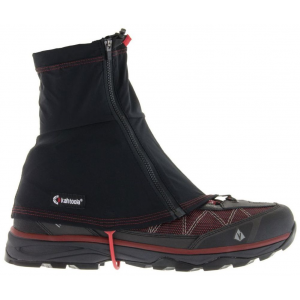Spring weather can serve up anything from sun to snow so a spring hiking outfit needs to be ready for anything. A day can start out cool, warm up, and then cloud over before thunder showers or wind. Depending on the location, snow may even be on the trail or in the forecast.
As always, the key to dressing for hiking is being able to add and remove layers to stay comfortable. That starts with a comfortable base layer. For spring, the most important item to have is a lightweight jacket that provides some warmth plus rain and wind protection. A fully wind and rainproof shell is also good to have in case of extreme weather.
On the bottom half, hiking pants work unless you have other preferences. Add a base layer of long underwear or tights for more warmth. In some places, but not all, rain pants are good to have.
Between spring showers and snow melt, trails are often muddy and wet. Waterproof footwear is absolutely recommended. Boots will keep water from splashing in. For low top shoes, waterproof socks or gaiters keep moisture and muck out. And if there could be snow, carry micro spikes.
Last, gloves, beanie, sunglasses, and maybe a buff protect the rest of the body. That may seem like a lot but the two most important items to have for a spring hike are waterproof footwear and a good mid-layer. Check out our top picks to put together a spring hiking outfit.
Spring Hiking Jackets
A hiking jacket for spring needs to have insulation, block wind, and have some kind of water-resistance. Weight and breathability are also considerations. A variety of lighter jackets can work including light to medium-weight fleece, lightly insulated coats, and soft shells. Hiking vests are also an option this time of year. I like an attached hood for built-in protection against wind and rain. Many jackets come hood but not all.
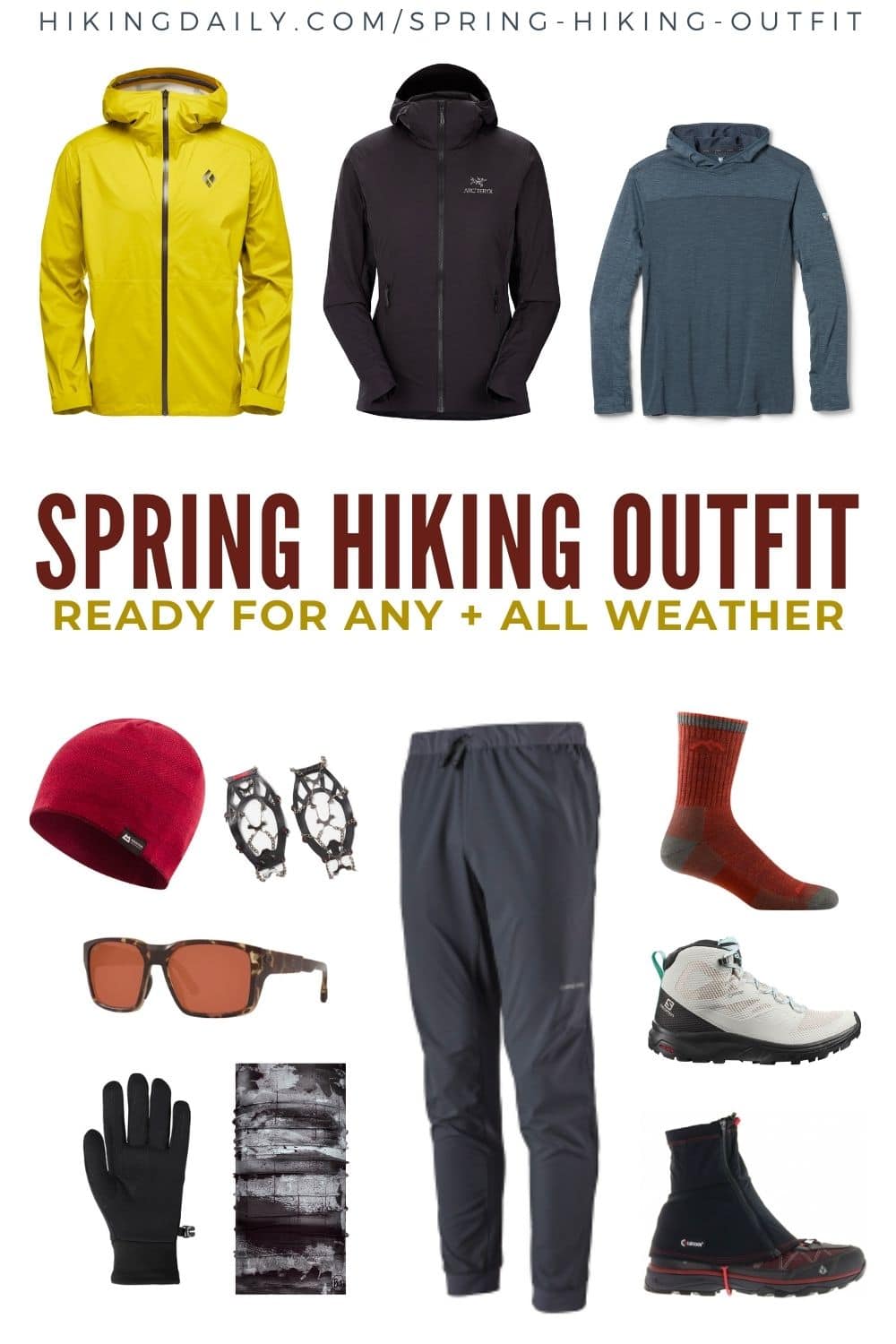
A spring jacket or vest should provide mix of weather protection and comfort including:
- Warmth
- Water resistance
- Wind resistance
- Light weight
- Breathability
Try one of these excellent mid layers for spring hikes.
Arc’teryx
Atom SL Hoody
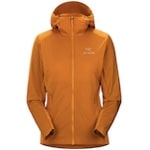
8.1 oz (W), 9.5 oz (M)
Windproof
Water-resistant
Breathable
Synthetic insulation
100% nylon, 93% polyester/7% Elastane fleece side panels
bluesign fleece side panel
Jack Wolfskin
Go Hike Softshell
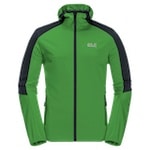
12 oz (W), 15 oz (M)
Windproof
Water-resistant
Breathable
Fleece lining
100% polyester Flex Shield Shell, Stormlock Warm Lining
bluesign product, Green Point certified, PFCfree
Helly Hanson
Paramount Softshell

16.5 oz (W), 19 oz (M)
Windproof
Water-resistant
Breathable
Fleece lining
90% polyester/10% elastane shell, fleece lining
bluesign product, PFC-free
Arc’teryx Atom SL Hoody (Men | Women | W Revised Fit)
Weight 8.1 oz (W), 9.5 oz (M)
Waterproof DWR finish
Material 100% nylon, 93% polyester/7% elastane fleece side panels
+ Lightweight + packable
+ Insulated with 40 g/m² Coreloft
+ Stylish slim fit
– Pricey
This stylish and functional hoody with weather resistance is just right for mild spring and fall conditions that still need some insulation. It blocks wind and some water but also has stretch fleece side panels for ventilation. Synthetic CoreLite insulation stays warm if damp and dries quickly.
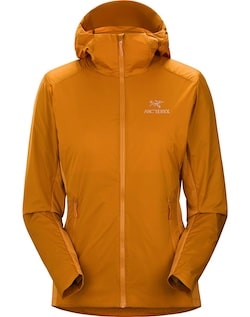
The SL stands for Super Lightweight and at 8.1 ounces for women and 9.5 ounces for men, it offers lightweight protection that packs away easily when the weather warms up. Check out the six different color options, a slimmer version for women, and the Arc’teyrx outlet for deals on discontinued colors.
The Atom SL line is also available in a vest and 3/4 zip anorak.
Jack Wolfskin Go Hike Softshell (Men | Women)
Weight 12 oz (W), 15 oz (M)
Waterproof PCF-free DWR finish
Fabric 100% polyester Flex Shield shell, Stormlock Warm Lining
+ Slim fit but not tight
+ Stretch
+ bluesign product, Green Point certified, PFC-free
– Needs lower layers
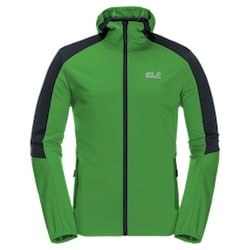
This sustainably produced jacket is a mid-layer that will get use year round. The STORMLOCK fabric provides breathable stretch that keeps out wind and water and a soft lining. I have this jacket and it is my go-to for cool and windy weather. I also appreciate the slim but not-too-close cut that flatters while leaving room for layers, like the lightweight JWP Midlayer Fleece or Hydro Grid Fleece.
The softshell comes in a bright and neutral colors for both men and women, with some colors at a discounted price.
Helly Hanson Paramount Softshell Jacket (Men | Women)
Weight 16.5 oz (W), 19 oz (M) without hood
Waterproof PFC-free DWR finish
Fabric 90% polyester/10% elastane shell, fleece lining
+ Hooded, no hood + vest options
+ Flattering fit with side panels
+ PFC-free, bluesign product
+/– Long sleeves
– Limited colors

This jacket does exactly what it’s supposed to do – resist water, resist wind, and breathe – all while looking and feeling great. The lightweight shell is designed to add extra layers so size down for a closer fit. Available in only black for women and black or navy for men, this coat doesn’t look like activewear and is at home in the city as well. I like a hood to block wind or rain but this softshell is also available without. It also comes in a men’s and women’s vest and men’s hood and women’s hood.
Check Amazon to get it for half the price.
What Is DWR?
What is this DWR we keep talking about? It stands for Durable Water Repellent (DWR), a finish applied to fabric that repels water as well as stains. In the past, DWR was made with PFCs that leave behind toxic and persistent by-products in land and water. Some outdoor brands have developed PFC-free DWR while others are using short-chain PFC DWR that is less toxic and break down faster until a better solution is found.
A DWR finish was never permanent and the newer DWRs wear faster than before, requiring more frequent refreshing. The good news is that simply involves washing and drying, something that should be done regularly anyway.
If a softshell starts to feel different, the DWR is likely compromised. Water may begin soaking in instead of beading up and rolling off. It may also feel less breathable.
To revive the DWR, wash the garment according to manufacturer’s instructions, paying special attention to the detergent that is used. A technical fabric cleaner like NikWax Tech Wash is designed to remove dirt and oils without leaving anything behind that could interfere with the fabric or DWR coating.
Then dry the garment, in the dryer if instructions permit it or in the air. The key to DWR re-activation is an additional heat cycle. Tumble dry on low for 20 minutes.
If that is not enough, an additional coating may need to be applied. Abrasion in the cuffs and collar or anywhere there has been friction will remove DWR. Spray-on DWR can be re-applied to those areas. There are also wash-in DWR formulas but they also coat the interior, potentially impacting functionality and breathability.
Hard Shell aka Rain Coat
It is always good to have an outer shell for sudden turns in weather. A hard shell provides complete protection from wind and water. If there isn’t room, most hiking backpacks have an area that a garment can be strapped to externally. Many of these rain jackets also fold up into a small pouch.
Rain jackets are not known for their breathability but the fabric technology keeps improving. Shells can still get warm so underarm ventilation, also known as pit zips, are a must have for me.
Rain Jacket Layers
There are three types of waterproof jackets: 2 layer, 2.5 layer, and 3 layer construction.
2 layer fabric has a bonds a protective inner coating (DWR) to a face fabric like nylon or polyester.
2.5 layer fabric sprays sprays DWR between the outer and inner layer.
3 layer fabric really has 3 layers with a membrane sandwiched the outer material and a liner. Goretex is the most well-known example of a 3 layer fabric.
For most people 2.5 layers is adequate and will be lighter, softer, and cheaper. A 3 layer fabrics tend to be stiffer and sometimes louder but they do offer complete protection from the elements and last longer.
Black Diamond StormLine Stretch Rain Shell
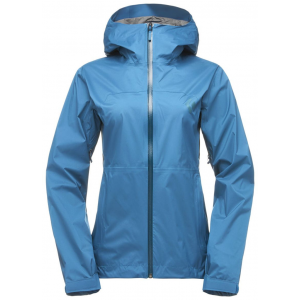
11.3 oz (M)
2.5 layer waterproofing
88% nylon/12% elastane
+ Stretchy fabric
Outdoor Research Helium Rain Jacket
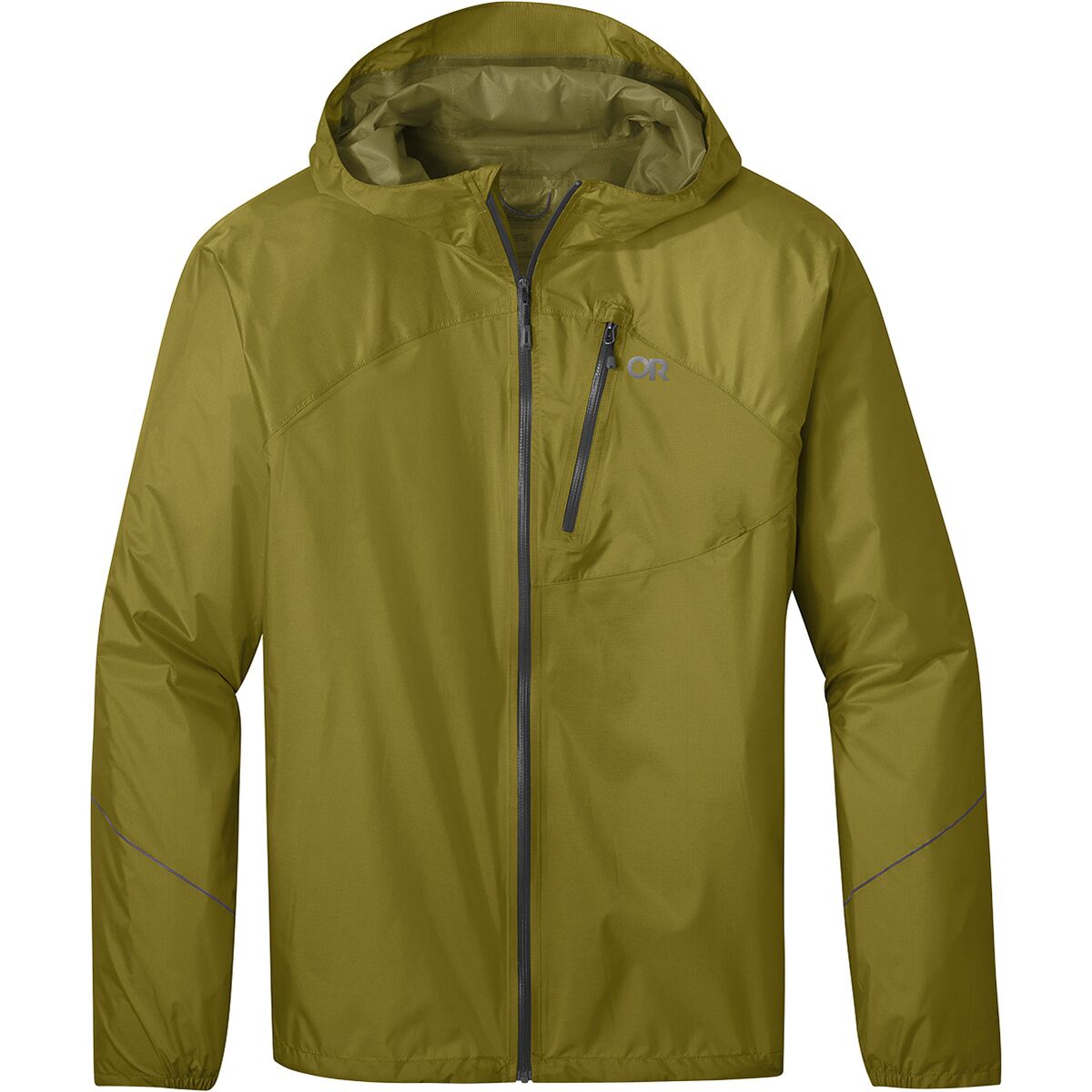
6.3 oz (M)
2.5 layer waterproofing
100% nylon (bluesign)
+ Ultra lightweight
Patagonia TorentShell

13.9 oz (M)
3-layer waterproofing
Recycled ripstop nylon (bluesign)
+ Most waterproof
Black Diamond StormLine Stretch Rain Shell (Men | Women)
Weight 11.3 oz (M)
Waterproof Yes – 2.5 layer stretch woven face with DWR finish
Material 88% nylon/12% elastane
+ Pit zips
+ Stretchy
This waterproof, windproof, breathable shell is ready for any weather. Unlike most rain jackets, the material is ultra-stretchy for more mobility, comfort, and durability. With pit zips, this shell is suited for moderate to downright bad conditions. Stay visible with a choice of 8+ colorways. When not in use, fold it up into a pocket.

Check Amazon for deals on some colors and sizes. Backcountry offers a percentage back through Rakuten.
Outdoor Research Helium Rain Jacket (Men | Women)
Weight 6.3 oz (M)
Waterproof 2.5-layer Pertex Shield
Material 100% nylon (bluesign approved)
+ Lightweight
+ Packs small
+ Sizes up to 3x for men and women
– No pockets

This is the rain jacket you want when caught in a downpour. It is everything you need and nothing more. It blocks all wind and rain while breathing so you don’t overheat. The bluesign approved fabric is as thin as can be and resists abrasion. There are no side pockets to prevent leaks and the chest pocket can be used as a stuff sack. It is everything you need and nothing more
Patagonia TorentShell (Men | Women)
Weight 13.9 oz (M)
Waterproof 3-layer H2No Performance Standard shell
Material Recycled ripstop nylon (bluesign approved)
+ Pit zips
+ Hood fits well
+ Fair Trade Certified sewing, bluesign polyester
– Fit doesn’t work for everyone
The cleverly named TorentShell is one of the best rain jackets available at a reasonable price. It’s not a budget option but the best value. Now updated with 3 layer construction, the popular jacket is even more waterproof. A microfleece-lined neck protects the chin from irritation when coat is zipped all the way up. It also folds up into a pocket and can be attached to a carabiner.

Base Layer
Every hiking outfit begins with a base layer. Whether your preference is synthetic, wool, or silk, wear a T-shirt for warmer days, long sleeve for cooler forecasts, or both to cover all bases.
Bottoms
Hiking Pants + Leggings
Spring is not quite shorts weather for most places and people, except for the shorts-year-round-crowd. While any synthetic bottoms – joggers, track pants, leggings – can work, make sure that the fabric will run off the material rather than sinking in. Any polyester mix will do this but cotton will soak up water like a towel.
A light- to mid-weight hiking pant is recommended for spring weather. Long johns can be added for cooler weather.
Check out these hiking pants that blend form and function.
Kuhl Silencr Pant (Men)
Material 100% ripstop nylon with 4-way stretch
Waterproof DWR finish
+ UPF 50 protection
+ Looser full fit style
+ Phone pockets
– Stretch fabric fits closer than other Kuhl full fit pants
In addition to a water-resistant finish, these pants provide UPF 50 sun protection. With a record 7 pockets, a phone can be comfortably carried on either side.
The full fit style has some room in the seat and thigh and wider leg from the knee down. Durable ripstop nylon stands up to rugged adventures and frequent wear, which will happen because the Silencr looks good enough to wear around town.

It comes in 8 neutral colors plus camo. The Silencr is also available with cargo pockets. Buy through the Kuhl website to get money back from Rakuten.
Patagonia Terrebonne Jogger Pants (Men)
Material Recycled polyester
Waterproof DWR finish
+ Lightweight (6 ounces)
+ Quick-dry
+ Fair Trade Certified sewn
– Too lightweight to use pockets

For a lightweight and relaxed fit, check out these ripstop joggers with a DWR coating and some wind blocking. There are pockets but a full set of keys or phone pull on the lightweight fabric. When you’re not hiking, these can be lounge wear.
Arc’teryx Gamma LT Pants (Men | Women)
Material 88% nylon/12% elastane
Waterproof DWR finish
+ Straight leg
+ Built-in belt
+ Drawcord hems
– Cost
These popular pants were recently updated with a more comfortable belt and redesigned pockets. The softshell pants resist water and wind with some insulation. The stretchy fabric and design provide a full range of motion. The leg length can also adjusted with drawcords. Like all Arc’teryx gear, the style and fit look great anywhere and everywhere.

The previous version of the women’s Gamma LT pant is currently discounted at REI.
Kuhl Klash Pants (Women)
Material 72 % ripstop nylon/20% polyester/8% spandex
Waterproof DWR finish
+ Available in 30 and 32 lengths
+ 4 zipper pockets + thigh phone pocket
+ Boot hook
– Waist doesn’t work for every body
This women’s softshell pant is ideal for spring and fall weather and even colder temperatures with a base layer. The durable ripstop fabric is abrasion resistant. The mid-rise, relaxed fit style with stretch ensures a full range of movement.

Mountain Hardwear Dynama/2 Ankle Pants (Women)
Material 94% nylon/6% elastane
Waterproof DWR finish
+ Wide waistband
+ UPF 50
+ Stretch
+/– Fit big
These comfortable joggers also protect from the sun, wind, and rain. Pockets are just big enough to warm hands and don’t add any bulk at the waist. The wide waist band and absence of zippers are comfortable even cinched into a backpack or hip pack.

An excellent final detail is the zippered bottom hem to fit over boots and a boot hook that attaches to laces acts as a gaiter to keep out cold and wet. Buy from the Kuhl website to get money back through Rakuten.
Waterproof Hiking Pants aka Rain Pants aka Hard Shell Pants
Fully waterproof pants for hiking are a shell worn over another layer, similar to a rain jacket. Waterproof pants can be brought just in case or worn over a favorite base layer.
These are the bottoms that go with the recommended jackets.
- Black Diamond StormLine Stretch Rain Pants (Men | Women | )
- Black Diamond StormLine Stretch Full Zip Rain Pants with a zipper all the way up the leg to put on easily and ventilate (Full Zip Men | Full Zip Women)
Gaiters
Water, mud, and dirt can get into waterproof footwear at the ankle. Gaiters keep everything out. For spring, mid-calf or knee high gaiters will keep shoes and pants clean and clear. Some gaiters have unisex sizing while some have men’s and women’s versions.
Spring Hiking Boots
Between melting snow and rain showers, spring is the wettest time of the year. Even with gaiters, waterproof footwear is a must. There are lots of options so here’s how to choose hiking footwear and the best hiking boots for women and men.
Hiking In Mud Season
In between the snow and sun, it’s mud season.
In general, the best tip for hiking muddy trails is don’t. Hiking through, or worse around, the mud damages trails and the surrounding vegetation.
Most people try to avoid mud puddles by going around. This begins to widen the path and cause erosion by damaging the plants and root systems that hold the the soil around the trail together.
So just walk through the mud, right? While that is better, it is still not ideal. Hikers leave behind deep footprints that harden into deep ruts that are hard to walk on. A few seconds of hiking through mud can create hours of work for rangers.
Here in Colorado, I don’t find hiking in mud to be enjoyable. The soil has a high clay and silt content thanks to the inland sea that covered the state 70-100 million years ago. This mud builds up on boots until you’re on a platform and looking for a rock to scrape it off. This type of soil takes longer to dry out than sandy soils, so sometimes the weather is ready for hiking before the trails.
